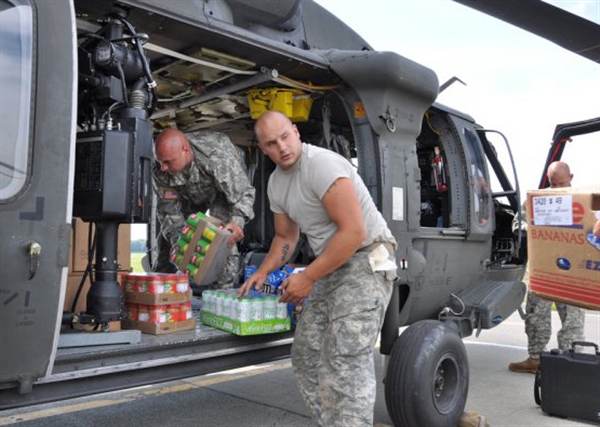 New York Army National Guard aviation soldiers Sgt. Larry Sloan, left, and Sgt. Jason Dolan, centre, a load food into a UH-60 Black Hawk helicopter as part of state emergency response efforts in the wake of Hurricane Irene.
PHOTO: US Dept of Defense |
Donations and uses of forklift services have followed in the wake of Hurricane Irene, a category 3 storm that primarily pummelled oceanic islands and the East Coast of the US.
The Material Handling Equipment Distributors Association (MHEDA) of Vernon Hills, Illinois alerted its members about donation opportunities through the American Logistics Aid Network (ALAN).
"Many MHEDA members have stepped forward to offer donated or discounted equipment," says Kathy Fulton, ALAN director of operations.
In the wake of Hurricane Irene, ALAN continues to work with relief agency partners to identify critical supply-chain-related needs and communicate to members of ALAN's network.
Among responders, Modern Group Ltd is providing two solid-tyre Hyster S50 forklifts and two Hyster pallet jacks to the American Red Cross of Northern New Jersey under a donated 10-day rental.
Modern is "doing a tremendous effort with disaster relief", says Ray Shepherd, CEO of the Fairfield, New Jersey-based agency. "We received seven tractor- trailers of relief supplies. With the forklift, we can get the pallets of meals and home cleanup kits off quickly and distribute them. The equipment has greatly facilitated our effort."
Dave Griffith, president and CEO of Modern, says the equipment comes from the dealership's rental fleet.
Modern lost electrical power on 27 August and regained utility service on 31 August. "We are a Generac (Power Systems Inc) dealer and had portable power" on site, Griffith notes. "We have donated the use of a couple of generators."
Modern is based in Bristol, Pennsylvania.
Another ALAN responder, Maybury Material Handling, provided a Crown pallet truck to the American Red Cross of Central and Western Massachusetts for the movement of food, water and supplies.
"We put the offer out there" to those with materials handling needs, says John Maybury, president and owner of the dealership in East Longmeadow, Massachusetts.
Maybury Material Handling had provided other equipment in support of the Red Cross chapter in Springfield, Massachusetts following disruptions from the 1 June tornado.
A liquefied petroleum gas-powered Toyota forklift was put to effective use in Ledyard, Connecticut on 1-2 September.
Ledyard Mayor Fred B Allyn Jr called Holdridge Home & Garden Showplace, and "we responded in 10-15 minutes", says Tom Shafer, store manager, who drove the forklift, which has a 3,000 lb. (1,350 kg) lifting capacity.
There was no time to load the forklift on a trailer. Instead, patrol officers hastily assisted Shafer in getting the forklift safely through Ledyard street traffic to the town centre to "unload water and MREs", he notes. "We had power and could fill the propane tank."
The Holdridge store operates two Toyota and one Allis forklifts.
The list of effective forklift uses is extensive.
Volunteers at an American Red Cross location in New Jersey drove forklifts to move emergency supplies, unload tractor-trailers of ready-to-eat meals and reposition cots, blankets, coolers and diapers.
In advance of the hurricane's arrival, marina operators along most of the East Coast used heavy-duty forklifts to urgently pull boats out of the water and quickly move as many of them as possible to temporary storage in safer locations.
Far from the centre of the storm, electric generator maker Generac put forklifts to work in its Whitewater, Wisconsin facility positioning stock for transport to the energy-starved East Coast. The plant in the Midwest manufactures air-cooled engines, RV generators and air-cooled generators. Generac is based in Waukesha, Wisconsin.
The faith-based Convoy of Hope organisation in Springfield, Missouri put its Toyota forklift to work assembling supplies and loading trucks for movement to the East Coast, initially targeting North Carolina for the goods.
Hurricane Irene formed in the Atlantic Ocean on 20 August, reached inhabited areas by 24 August and dissipated on 29 August.
In tracking northward, the hurricane hit the US territory of Puerto Rico and the southern islands of the Commonwealth of the Bahamas, made landfall in the US states of North Carolina, Connecticut, New Jersey and New York and extended into the state of Vermont and Canada's eastern provinces.
Some 55 people died, and damage was estimated at USD10.1 billion.